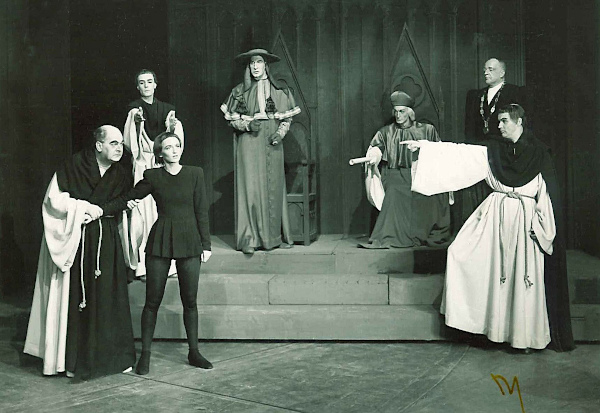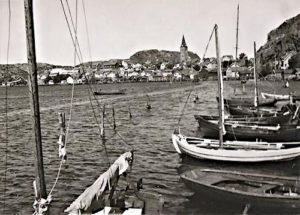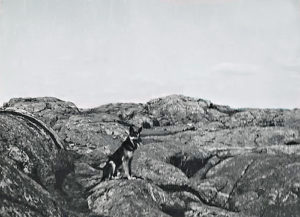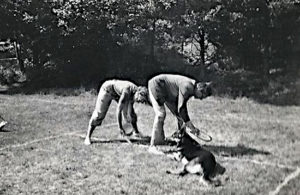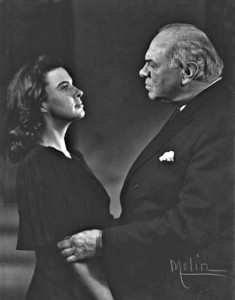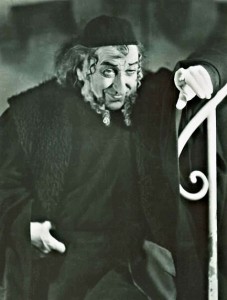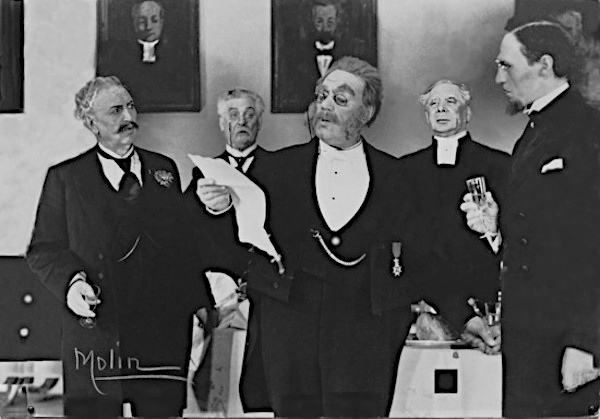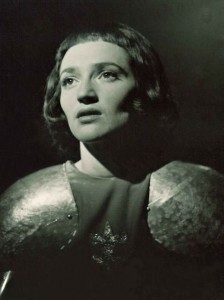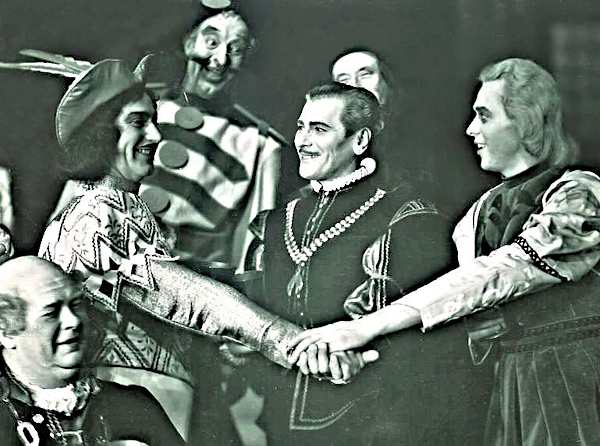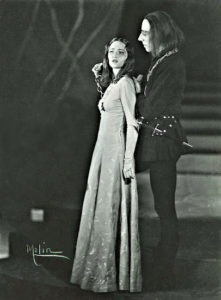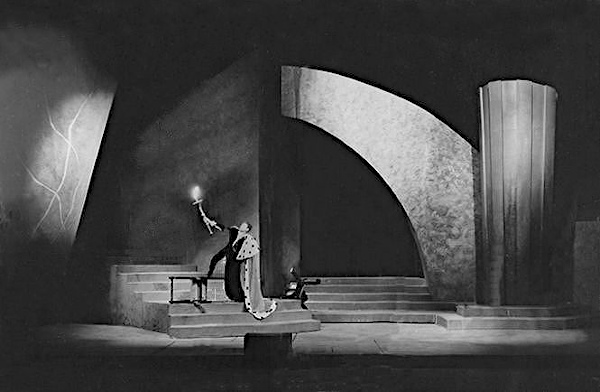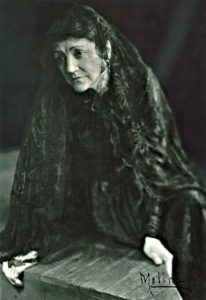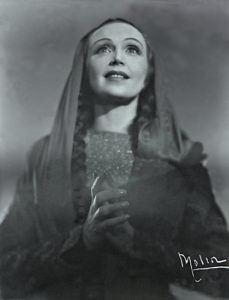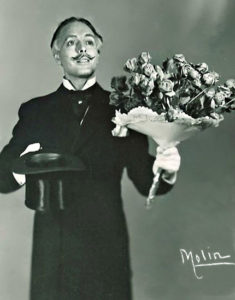Chapter 4 – My youth and the theater
At the beginning of our lives Mother loved us, me and my sister Gun. She was loving and caring. She laughed and played with us. But things changed and you could never depend on her being there for us, for my sister and me. Nevertheless, I was probably seen by most people as a privileged child.
There was the divorce and a cloud came over us all. Mother became unpredictable and unstable. We were not always sure what was coming next. At the same time there was the war, and the cloud was all over Europe.
When the war was over and Arne became part of our family, things became more stable. Arne shared his stability with all of us. His stable upbringing helped him throughout his life and its ups and downs.
I may have been, in a way, a privileged child and young girl. In spite of the lack of stability there was love and laughter in my life. And there was also a lot of fun. However, I always felt as if I was on the fringe, not quite belonging, and that is probably a feeling I have had ever since my parents divorced when I was about ten.. But by and large, I was at peace with myself in my teens. I had a feeling of somewhat belonging, even though I was so different from most of my friends in the style of living of my family. We were not bourgeois. My mother was not home cooking and taking care of us all.
We had wonderful vacations in Lapland and also on the beautiful Swedish west coast — a good life essentially.
The west coast of Sweden, a province called Bohuslän was a paradise which had nothing in common with Lapland. There are rocky islands, sounds and bays and wonderful but pretty cool swimming.
The whole family went there in 1949, Sappo included. Arne and I had been there on a short trip the previous year when Gun and Mother went to Lapland. (That was the summer I was being confirmed — heaven only knows why! — so I guess Arne was baby-sitting with me.) In 1949, however, I told Mother I would like to learn to take pictures. She reached up to a shelf behind a sliding glass window in the store she managed and got a camera down for me.
It was not the best obviously, but nor was it a cheap camera. I practiced and most of my pictures were so-so, but after all I was just a beginner.
Mother had given me a very good lesson about settings of aperture and time, for snow and water, a sunny sky, and different times of the day. I did my best. Obviously, in those days, you set the aperture and the time by hand. Later on, with my next camera in 1970, a Kodak that was a bit better than my first camera, I became a bit more proficient.
My new camera allowed for shorter time exposure and larger aperture capacity. I then also got an exposure meter (that tells you what exposure is required). That was fun. It was attached to my camera, in its own case. And that was the camera I had when I got to know John in January 1971. I took a mass of photos of Paris and of our travels with that camera.
In my youth we always traveled by train, as one did in those days. Once we had arrived in Hamburgsund (originally Homburgsund) and after finding the house where we had rented the upper floor apartment from a very tidy fisherman’s family, we felt ready for a dip in the ocean, the North Sea here, and wow is it salty.
We told the normally very obedient Sappo to stay on shore as we swam out to get the train aroma off our skin. But as we were pretty far out from land, we suddenly heard some heavy breathing behind us. Sappo had clearly become worried somehow. Were we going to leave him? Were we in danger and he had to come and rescue us? He had decided to swim out to where we were to rescue us if need be. What an extraordinary dog.
That was the summer I experienced my first epiphany. We had walked out to the western edge of the island, all four of us, or five since Sappo was always with us. Once at the side of the water we all searched out our own flat rock to lie on. I closed my eyes and the sun was warm on my face and body. Then suddenly a miracle happened and I was one with the rock under me and the rocks around me. It was a most extraordinary feeling of being part of nature. Time stood still and there was only the close-by eternal sound of the breaking of big waves, the long rollers coming in from the North Sea. I have had a similar experience a few times later on in life, but it’s a rare moment when it flashes by, a whiff of eternity and of unending peace and beauty.
As for the photos, I am glad I have made some progress as a photographer since those days, that is in my grown-up days. In Luxeuil-les-Bains though, I had my first camera and my pictures there were not good.
Boyfriends and dancing at outdoor summer dancing places with mostly an accordion playing the part of a band. My sister Gun and I either brought our bikes from Malmö on the train, in the luggage car, or we borrowed bikes from the family where we were staying. I remember biking around unpaved roads in Bohuslän to these dance places, roads that traffic and rain had made into giant washboards. Our hands would tingle after a while on those washboard roads.
There is an event that stands out in my memory of this very pleasant summer. A young fisherman had a crush on Gun (nothing unusual, all young men did) and so he invited us to go out one night fishing mackerel, and we were more than willing. It was a rather small boat, two or three fishermen, and they threw out, I believe, four lines on either side of the boat, each line having several hooks. There was constant activity. One line is put out and on the other side of the boat another line is pulled in, the fish unhooked and thrown into a vast container.
We loved the entire experience, the night out on the sea and watching the hard-working fishermen. In Swedish it is called ‘dörja makrill’. The thing that sticks in my mind more than the rest though is the cod they caught. There is of course no guarantee that only mackerels are going to take the bite. So they caught a cod. They said they didn’t know what to do with a cod, so did we want it? In those days cod was known as the most everyday fish, but good enough. Of course we wanted it.
So we walked back to ‘our’ house and Mother boiled the cod in nothing but salted water. In the big kitchen on the upper floor of our rented apartment we sat down right away after the ten minutes, or so, of cooking time. It was the best fish I’ve ever eaten in my life. It was about one hour old and I had never eaten fish that fresh before. Wrong. Two years earlier, Park Nisse, the National Park Guard in Abisko had let us fish trout with his fishing rods and Mother cooked them on the wood stove in the National Park hut in Abiskojaure. It was an equally unforgettable delicacy.
_______________
Back to Malmö and my friends. We used to have little parties most Saturday evenings with the same group of ‘kids’, as Americans would say, (or even ‘guys’) at our place or someone else’s, depending on whose parents were out that Saturday evening. A group of girls and our boyfriends, who sometimes changed. We collected 78 rpm records (now called stenkakor, stone cakes) and we danced to Louis Armstrong, Ella Fitzgerald, Fats Waller, Nat King Cole, Glenn Miller, and many others. Basically we had fun. We worked hard in school, but weekends were still time for breathing and relaxing with friends.
I was extremely fortunate to have my stepfather, Arne, as a constant stimulation to make me interested in the world around me, in history, in reading, in music, and of course in the theater. In that way I was indeed a most privileged teenager. We had a beautiful apartment and we sometimes took evening walks with Sappo, our gorgeous German shepherd, in Slottsparken or in the park in front of our apartment building. Occasionally we would join the evening dog club on the vast field bordering on the water front, Öresundsparken. This was the park between our street and the sound, Öresund, that separates southernmost Sweden from Denmark.
And our wonderful Sappo had a buddy, a cat whose name was Figaro. In fact there was first svarte Figge (black Figaro) and later vite Figge (white Figaro).
When we were lying out on the lawn in the park on a sunny afternoon, as soon as Figaro climbed up in a tree, Sappo would stand guard at the base of the tree, watching out for other dogs who might not like Figge as much as he did.
Arne had given our cats their name because of his favorite opera which was Mozart’s ‘Marriage of Figaro’.
It really is a coincidence that John picked the same name for our present cat, who is Figaro. (until 2013 — time flies and it’s taken me a long time to write these memoirs along with other big projects.) Figaro is very black, an Egyptian-style black cat, as loving, loved and adorable as can be imagined.
Back to Malmö. In the winter we went skating on the two fairly large ponds in “our” park, Öresundsparken. I was never a really good skater, but the air was crisp, the park was beautiful, my friends were there and I enjoyed it.
From our balcony, where we sometimes had dinner on light summer evenings, we could see wonderful sunsets over Copenhagen and on clear days we could recognize most of the various towers in the city: the stocky Round Tower, the Marble Church with its round dome, Our Savior’s church (vår frelseres kirke) the City Hall tower, the Stock Exchange that had the most extraordinary tower of them all, huge snakes wound around the tower all the way to the top, — Christiansborg Castle, which houses the Danish Parliament, with another easily recognizable tower, and the Nicolajkirke with its green tower. It has now become a modern art exposition hall. It became a game to pick out the towers and name them. Marmorkirken, the domed Marble Church, was the easiest one.
___________________
And of course there was the theater. There was the new Malmö Stadsteater (Malmö City Theater) inaugurated in September 1944, a repertory theater, the biggest one in Sweden and the most modern one in Europe at the time.
Gun and I saw many of the plays and we loved those evenings. Arne would usually get the seats of the director of the theater when it was not the premiere, so we were very well seated. Mother and Arne would usually attend the premieres, dressed in formal evening wear, and I remember one time Arne said that only he and the Mayor were wearing top hats, the ones that went with what we and the French call frack (frac). Oh, how times have changed. You can still see evening gowns at Malmö Stadsteater, but formal evening wear for men is definitely nothing but a memory.
Shakespeare’s ‘A Midsummer Night’s Dream’ was the inauguration play, directed by Sandro Malmquist, our first director of the theater and a superb metteur-en-scène, who had studied drama with the historical Max Reinhardt in Berlin. Since the theater was the pioneer in Sweden for school performances, I saw it with my grade school class, the year before I started secondary school, at that time called läroverk.
Before the beginning of the play, a man came out from behind the heavy red curtains decorated with white theater masks. He talked to us about Shakespeare and the play. We were all eagerly listening. He came across as a very good pedagogue. That was Arne, my future stepfather. He came into our lives the very next spring. (At dinner one evening a couple of years later, I happened to say, in a Freudian slip, ‘before we married Arne’ a lapsus that has gone down in history.)
Mother was the theater’s photographer from the spring of 1945, and I have very recently found that her photos are archived at what is now called Malmö Opera Arkiv. A vast number of her photos are on the Internet. Those were my absolute favorite photos by Mother. She had already taken excellent photos at the children’s theater (Malmö barnteater) in the Amusement park (Folkets Park) in Malmö, and she became the photographer of our new theater very soon after its opening.
I have now saved and treated all the 661 photos I could find of Mother’s from the Internet, but most with the enormous and enthusiastic help of Elzbieta Fasciszewska Lejczak who managed the Malmö Opera archives until 2016 when the archives were moved to Kungliga Biblioteket in Stockholm. It took me three years to complete that task. Elzbieta became much more than a cooperator – she became a close friend and I hope we will always stay in touch.
Some performances stand out. First of all, on Intima teatern, Jean Anouilh’s ‘Antigone’ in 1948, wonderfully directed by the new director of the theater, Stig Torsslow. “The play was first performed in Paris at the Théâtre de l’Atelier on February 6, 1944, during the Nazi occupation. Produced under Nazi censorship, the play is purposefully ambiguous with regard to the rejection of authority (represented by Antigone) and the personification of authority (represented by Creon). The parallels to the French Resistance and the Nazi occupation are clear, however.”(Wikipedia)
Oscar Winge, who played Creon, the ruler of Thebes who succeeded Oifipus, had always been associated with operettas and he was the former director of the operetta theater, Hippodromen. Stig Torsslow had now found out that he was also a superb actor. He probably weighed well over 200 pounds (It was really funny to watch him getting into his tiny Fiat, it was a push and a squeeze.) – but wow, the stage presence! Antigone was played by Gun Robertson who was a somewhat uneven actress, sometimes average, and sometimes, as in this performance, absolutely superb. Getting an actress/actor to surpass his standard best is the work of a good director, the metteur-en-scène. I remember Oscar Winge as Creon sitting on his ‘throne’, and Antigone arguing with him, standing on the left of the stage. His throne was a white straight-lined construction in the center of the stage at the ‘intimate’ theater (Intiman), which has just a couple of hundred seats. I was 15 years old when I saw it and I was spellbound.
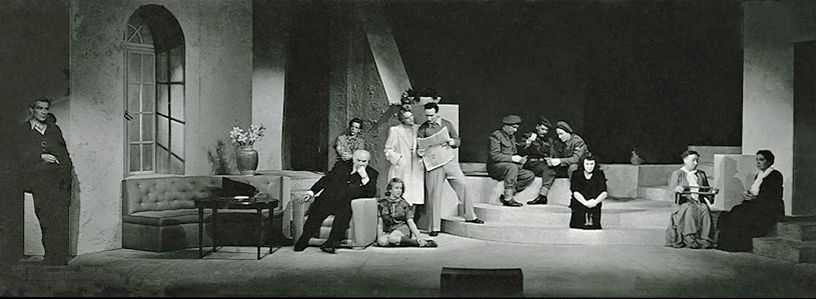
The opening scene of Antigone. Creon is in his armchair, Antigone in black is in the center-right. The narrator (chorus) is leaning on the wall, left.
I read the play, when I was a student majoring in French at Lund University, and I will always find ‘Antigone’ to be one of Anouilh’s very best plays.
Antigone, Creon’s niece, is the epitome of a rebel and Creon, of stubborn pride. She represents the angry and youthful rejection of authority and Creon is the very embodiment of that authority.
After the death of Oedipus, their father, Antigone’s two brothers are competing for the throne of Thebes. This infighting ends up in a duel that leaves them both dead. Creon, the uncle who now becomes king, decrees that Antigone’s brother Polynice must not be buried, in order to set an example so that someone will be punished for this bloodletting. Antigone rebels and insists on burying Polynice, against Creon’s firm orders. Haemon, Creon’s son is in love with Antigone. Creon tries without success to convince Antigone to marry his son quickly and to abandon her plans to bury Polynice against his orders.
Antigone rejects all attempts to save herself and Haemon. She buries her brother with her own hands. She is immured and in the end she hangs herself. After his loved one’s death, Haemon stabs himself and on hearing this, his mother, the queen Eurydice, finally stops her knitting, goes up to her room and cuts her throat. Creon is alone.[1. Anouilh’s ‘Antigone’ follows relatively closely Sophocles’ play of the same name.]
Another favorite of mine was Shakespeare’s ‘The Merchant of Venice’, also performed in 1948, directed by the now historic director from the Royal Dramatic Theater, Olof Molander. The Jew Shylock was played by Anders Fritiof. Shakespeare was most certainly serious in his writing about Shylock as the shrewd and villainous Jew and moneylender, intended to be laughed at. Around 1600 that was not shocking. The play was listed as a comedy, along with all the Bard’s other far more lighthearted comedies. We actually know very little about Shakespeare as a person anyway. Shylock was certainly played as a repulsive clown during Shakespeare’s days and for a couple of centuries after that. [2. “This is made explicit by the title page of the first quarto: ‘The most excellent History of the Merchant of Venice. With the extreme cruelty of Shylock the Jew towards the said Merchant “. (i.e. Antonio) (Wikipedia)]
But the trend changed at the beginning of the 19th century and he has ever since then been portrayed much more sympathetically. I do not think anyone laughs at Shylock any more.

Georg Årlin as the town’s very sad intellectual and drunk, who ends up committing suicide (Our Town)
We also put on ‘Our Town’ by Thornton Wilder in 1948, a very inspired mise-en-scène by Gösta Folke that I still remember certain scenes from. It was such a very different way of writing and performing a theater play that I found it absolutely fascinating. No real set, no props, a stylized play about the fleeting scenes in the life of a town. Something absolutely new to me – and probably to most of the audience when it was first performed in Princeton, New Jersey, in 1938. I have learned since that the play has become required reading in lots of high schools in the U.S.
‘A Streetcar Named Desire’ (Linje Lusta) by Tennessee Williams, in the spring of 1949, also directed by Stig Torsslow, was another one of my very favorite plays on the small stage (Intiman). It was an excellent performance with guest performer Irma Christenson as Blanche, our own excellent Erik Strandmark as the Polish rough-hewn Stanley Kowalski and Agneta Prytz as Stella, so very different from her neurotic sister Blanche, who could not let go of their family’s past glory.
Now, because of Elia Kazan’s 1951 movie, I guess I see Marlon Brando as Stanley Kowalski, but ‘our’ performance was excellent as well, and it made me an admirer of Tennessee Williams for the rest of my life. I have read all his plays and I like them all. ‘Cat on a Hot Tin Roof’ may be my very favorite, and I have seen the 1958 movie at least a couple of times, a masterpiece by Richard Brooks. The actors, Elizabeth Taylor, Paul Newman and Burl Ives as Big Daddy are almost perfect, even if Elizabeth Taylor’s southern accent sounds just a wee bit affected.
Arne directed numerous plays, among them Joseph Kesselring’s ‘Arsenic and Old Lace’ and ‘Blithe Spirit’ (Min fru går igen) by Noel Coward. Among other plays there was the Danish comedy ‘Once upon a Time’ (Der var en åang) by Holger Drachman on the main stage, written in 1885, a play that had met with enormous success at Det Kongelige Teater in Copenhagen. It’s a fairy comedy that has become something of a national Danish comedy.
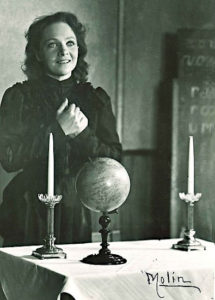
Agneta Prytz as Malin’s Maria, the high-strung young girl who believes she will give birth to a new Messiah.
Arne also directed Robert Louis Stevenson’s ‘Treasure Island’, which he had dramatized himself a few years earlier. Also, one of his major contributions to the theater was as a teacher of the drama students who often went on to excellent careers. Arne was a born pedagogue.
In another chapter I talk about our remarkable novelist and playwright, Hjalmar Bergman (‘His Lordship’s Last Will’, Hans Nåds testamente), which I saw at the Royal Dramatic Theater in Stockholm in 1961. In fact, Hjalmar Bergman may well be my absolute favorite of all the great Swedish writers. I believe I have read most of his novels twice. Also, when I worked on Mother’s theater pictures I read all the plays and, in the case of Markurels i Wadköping, I read again both the novel and Bergman’s own drama based on his novel that was what ‘we’ performed in Mazlmö. The title is the same, but the play is only built on what I remember as the last chapter of the novel, Markurell’s son and great pride in his life passing studentexamen (le baccalauréat) by various dubious means. This gradfuation is the entrance to a life of studies at the university, and learning.
The director was Sandro Malmquist and the legendary Anders de Wahl, a guest and one of the greatest actors from “Dramaten”, was the vulgar nouveau riche Markurell, the innkeeper, who has a beautiful wife played by wonderful Stina Ståhle. This tragicomic man nevertheless manages to move us when his life risks turning into disaster. It is, once again, as so often in Scandinavian literature, the eternal theme of who is the father of the young boy, in this case Johan.
Our theater produced so many excellent plays that I’d like to mention here, but I will first of all deal with two more plays mainly because of the excellent actors, or actresses in this case. First of all Bernard Shaw’s ‘Saint Joan’ (Sankta Johanna), 1946, with Inge Waern as Joan, also directed by Sandro Malmquist. Another very different play by Bernard Shaw was ‘Pygmalion’ with Viveka Linder as Eliza Doolittle, directed by Knut Hergel.
Of course, Shakespeare was well represented among our performances in those days and also later on. I have already mentioned ‘A Midsummer Night’s Dream’ and ‘The Merchant of Venice’’.
We also did “The Taming of a Shrew”, in 1946, directed by Sandro Malmquist with Edvin Adolphson as Petruchio , guest from “Dramaten” and Lillebil Ibsen in as Kate, the shrew, guest from Oslo.
There was a stunning production of “Hamlet’, also directed by Sandro Malmquist who was the designer of the amazing stage sets. Gunnar Sjöberg was a much lauded Hamlet, even though Sandro Malmquist had made him the ugliest Hamlet that ever was and beautiful Inge Waerb as Ophelia The great EElla Eronen, guest from Helsink,i was Queen Gertrude.
It got rave reviews, and Gunnar Sjöberg in the role of Prince Hamlet was highly praised. (The Finnish-Swedish guest performer from the Finnish National Theater, Ella Eronen, one of the most prominent theater artists of her time, was a sublime queen Gertrude.
Our own Inge Waern was equally convincing and also probably the most beautiful Ophelia on any stage the audience has ever see . Her ethereal beauty brightened many of our performances at Malmö Stadsteate From Ophelia to Pirate Jenny in The Three-penne Operar. to Joan of Arc in Georhe Bernard Shaw’s play, Saint Joan, to light comedies, such as Noel Coward’s That Was a Man (Man av ära) and one of very favorite plays ‘Cirkus Sanger’ ‘The Constant Nymph’ by by Margaret Kennedy. I read both the novel and the play based on it, and I loved both The one thing I have against the play is the title in English. Teresa or Tess is not a nymph, the way I see a nymph. She is a young girl who has been in love with a somewhat older, bur still young, man most of her liffe.
We performed ‘Blood Wedding’ (Blodsbröllop, Bodas de sangre) by Garcia Lorca, premiered in April 1946. It was directed by Sam Besekow, and the mother was played by the great Elsa Widborg, a guest from the Royal Dramatic The bride was played by Gun Robertson and the froom by Anders Ek. .
Shakespeare was always produced on the big stage of the theater that seated 1600 people. Among other memorable productions on the big stage, I vividly remember August Strindberg’s play ‘A Dream Play’ (Ett drömspel). It was a magic performance, directed by the Swedish Strindberg specialist, Olof Molander from the Royal Dramatic Theater in Stockholm.
Molander used a star cast with, first of all, Inga Tidblad (also from ‘Dramaten’) as Indra’s daughter, possibly the most inspiring Swedish actress ever. Arne would tell us that Olof Molander was a genius for sure but that, when he was not pleased with a performance, the actors trembled and sometimes broke down in tears.
‘A Dream Play’ has been considered the first of the theater of the absurd. It is a long fluid dream with the major theme being Indra’s daughter’s repeated line ‘Humans are to be pitied’ (Det är synd on människorna).
Indra’s daughter has come down to earth to find out if people are actually as unhappy as they are said to be. She now takes the place of the gatekeeper at the opera (called the ‘portress’ by the translator).[3. Translation by Edwin Björkman, London, Duckworth & Co, 1912, the same year Strindberg died.]
She is now going to listen to the sufferings of all the people who have confided in the portress, sufferings that have been collecting in the gatekeeper’s shawl for thirty years. The shawl is heavy. Indra’s daughter finally can no more stand all the misery of humans that she has been witnessing. In the end she returns to where she came from, to her father Indra wherever he is.
Maybe the most surrealistic scene in this long and varied dream is when the officer recurrently comes up to the château (which is also the opera) with a bouquet of flowers for his beloved Victoria — who does not exist — and he sings every time as happily and expectantly “Victoria”.
ngg_shortcode_0_placeholder” order_by=”sortorder” order_direction=”ASC” returns=”included” maximum_entity_count=”500″]
I saw ‘A Dream Play’ much later in Paris but it wasn’t at all what it could have been. It is a surrealistic and poetic play, but maybe it takes a Swedish director to get into the thwarted mind of Strindberg.
One more play on the big stage that stands out in my memory is ‘The Threepenny Opera’ (Tolvskillingsoperan) by dramatist Bertolt Brecht and composer Kurt Weill, which the theater produced in 1946.
Brecht had adapted his play from John Gay’s 18th-century ‘The Beggar’s Opera’ and it’s a powerful social critique of the capitalist world and a sympathy for the poor, from prostitutes to the Beggar King who keeps an army of poor rascals who pretend infirmity in order to get the rich to condescendingly throw them a few coins.
The ‘opera’ takes place in Soho in London. In a love duet with Mack the Knife, Polly Peachum sings “Siest du den Mond über Soho? Wo du bist da will auch ich sein.” — really the only love song in this play. Mack the Knife responds accordingly and all is romanc –, for a while.
Back to the beggars. Every morning Peachum, the beggar king, sends out his army of beggars who come back in the evening to give him the loot and discard their wooden legs or whatever means it took to turn them into cripples. It is also a love story of course between Polly Peachum and Mack the Knife. The play was directed by Sandro Malmquist, our first director of the new theater in Malmö, and he made it a very memorable performance.
‘The Threepenny Opera’ was one of the major performances on the main stage where the width of the stage was wel used for many of the scenes.
Stina Ståhle and Robert Johnson, who were going to play Mr and Mrs Peachum, came to our home to listen to Arne’s recordings (78s of course) of the original performance with Kurt Weill’s wife, the unsurpassed Lotte Lenya. They wanted to get an idea of how the roles had been interpreted in the original staging. (I actually managed to get hold of that same recording on CD many decades later.)
I had started studying German in 1945 and I learned some parts of the lyrics of a few songs at that time. (Lied von Seeräuber-Jenny: Und ein Schiff mit acht Segeln / und mit fünfzig Kanonen / wird beschießen die Stadt!) [4. Literal translation: Song by Pirate Jenny: And the ship with eight sails / And with fifty cannons / Will fire on the town. However, the English translation at “Pirate Jenny” – “Seeräuber-Jenny” is the one you hear themost.]
ngg_shortcode_1_placeholder” order_by=”sortorder” order_direction=”ASC” returns=”included” maximum_entity_count=”500″]
This historical musical had its very first opening on 31 August 1928 at Berlin’s Theater am Schiffbauerdamm. It was made into a movie in 1931, with Lotte Lenia of course. Brecht and the Weill-Lenia couple decided to leave Germany for the United States in 1933, the year Jews and communists found Germany to be a very unsafe country to live in. The takeover by the Nazi Party and Adolf Hitler became a certainty after the elections in March of that year.
The Threepenny Opera has been so much in the center of my life as far as theater goes that I feel as if it were my very special play. After this wonderful performance at Malmö Stadsteater I saw it performed by Lunds studentteater, a very good show. Next I saw the 19331 orifinal movie with Lotte Lenia whose singing the “Seeraüber Jenny” (Pirate Henny) song is just perfect. When I hear it sung by any other singer, ever excellent Ute Lemper, the German multilingual singe, I still feel that it’s not quite right. I believe I saw that movie in the fifties when I was a student in Lund.
Next there was my great involvement in the production of that play at Mamaroneck High School theater, directed by our great speech and drama teacher Regina Frey, which I mention in another chapter. As a finishing touch to that wonderful experience, the members of the cast giving me and my then husband Allyn, as assistants to Regina, the LP record of the show in English. It was a wonderful gesture. I will also forever remember how our Tony Schwab as Mack the Knife was so terribly scared of singing der Kanonen Gesang”which he sings in a duet with his old soldier buddy. It went off just fine and there was no sign of any nervousness in either of the two singers.
Now, writing about all this, the wonderful play is once again getting into my system. I love to listen to the original recording that still have of course with Lotte Lenia.
_________________
Later on, in 1953, when I was a student at Lund University but still living at home, Arne and I saw Luigi Pirandello’s ‘Six Characters in Search of an Author’ (Sex roller söker en författare). It was directed by Ingmar Bergman who had then become the artistic director of Malmö Stadsteater. A more unconventional play will be hard to find and it was fascinating. I have later read the play and I can well understand how Pirandello is thought of as a precursor to the ‘Theater of the Absurd’, a term that was only coined in the sixties. ‘Six Characters’ was first performed in 1922. The term ‘absurd theater’ mostly refers to Eugène Ionesco, Samuel Beckett and Harold Pinter. Edward Albee is often included in this group, but I think he is in a category by himself. Be that as it may, ‘Six Characters’ has set its distinct imprint on modern theater.
Also when I was at the university, I saw Ingmar Bergman’s splendid staging of Ibsen’s ‘Peer Gynt’. That was in 1957 and on the main stage. Fortunately, a friend of mine suggested going to Malmö to see it since I took very few initiatives of this kind myself. It was enthralling throughout the five hours it took. It is very rarely produced in its entirety. The fabulous actress Naima Wifstrand, who was a member of the repertory theater, was superb as the mother and Max von Sydow as Peer Gynt was a dynamic force on the stage. At the age of 28, he already mastered the gift for acting he was going to develop even further, most remarkably under the direction of Ingmar Bergman.
I will never forget Naima Wifstrand towards the end of the play, when she is disillusioned with her son. She is sitting on a rock on the left side of the stage, peeling an onion — one layer after the other until there is nothing left. She is peeling the layers of identity in her son, Peer. There is no core, nothing at all. This is very likely one of the most famous symbols in theater history and “Peer Gynt” is also probably one of the best-known Scandinavian theater plays ever written.

Peer Gynt by his mother’s death bed — Naima Wifstrand and Max von Sydow. Direction Ingmar Bergman. Photo: Georg Oddner © Malmö Opera Archives
The main theme in this play is avoiding difficulties in your life by simply not facing up to them, which Böjgen, a supernatural evil being in Norwegian folklore, tells Peer to do. This monster in one scene is standing in Peer’s way and won’t let him get through on his path. He tells Peer to ‘gaa udenom’ (going around), that is to lie and cheat and compromise instead of facing up to every hard choice and difficulty in life. However, by ‘going around’ throughout your life you end up living a fake or quasi-life that has no real value. By the skin of his teeth, Peer is saved by the faithfulness of Solveig, his youthful love, now an elderly woman. He then finally becomes ‘himself’, which he has avoided all his life. But his mother Åse had dies before Peer set out on his wanderings all over the world and she won’t ever know that there was after all a core of reality inside her son.
We read Peer Gynt in Norwegian in Gymnasium (not all of it though, it was definitely an abridged version). It was a bit difficult, but we managed. We had a very ambitious Swedish teacher. The concept of going ‘udenom‘ impressed me enormously and it has stayed with me all my life when watching people live their lives.

Arne is directing a comedy by Noel Coward, ‘Min fru går igen’ (Blithe spirit) –Arne Lydén, Nancy Dalunde,, Marianne Aminoff, Curt Masreliez
The historical high point of theater in my youth was still ‘Tartuffe’ at Det Kongelige Teater in Copenhagen with the star Poul Reumert, who had played Molière at La Comédie-Française and Bodil Ipsen as Elmire, one of the greatest Danish theater stars ever. That was in 1948, and I have already describe this momentous event in Chapter 2.
Note: All the theater pictures in this chapter are by my mother, Magda Molin, (except the above photo from Peer Gynt, as stated) and they are presented here with the kind permission of Malmö Opera Arkiv. From 2013 to 2016, I collected the vast majority of my mother’s theater photos from the first few years after the inauguration of Malmö Stadsteater in the fall of 1944, some of which I have retouched.
Site for Magda Molin’s theater photos – LEVANDE TEATER I BILD (Living theater in photos) To get to the album “Best pictures”, click here
Continued: Chapter 5 — Piece in major and minor
